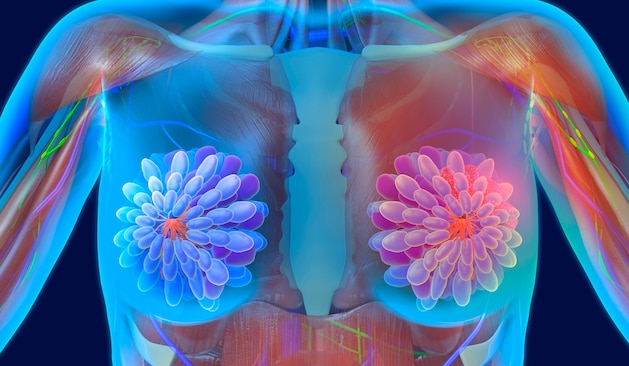Breast cancer is the most common cancer among women in Germany. The good news: Treatment has made enormous progress in recent years, meaning those affected have very good prognosis. A doctor explains what new medications are currently available.
Every year around 75,000 women in Germany receive the shock diagnosis of breast cancer. This makes it the most common cancer in women. According to the German Cancer Research Center (DKFZ), one in eight women in Germany will develop breast cancer in the course of their life. So frightening numbers.
But the good thing is that medicine has made enormous progress in the treatment of breast cancer in recent years. According to the DKFZ, most tumors are now curable because they are discovered early through early detection measures such as mammography and routine examinations by a gynecologist.
“Fortunately, over 90 percent of patients have no distant metastases when they are diagnosed with breast cancer, i.e. in the lungs, liver and bones,” confirms Sherko Kümmel, director of the breast center at the Essen-Mitte Clinic, in an interview with FOCUS online.
According to Kümmel, the latest treatment strategy for early breast cancer is as follows: “You start with the first systemic therapies such as chemotherapy, hormone or antibody therapy before the operation to see how it responds,” he explains.
The strategy is different for aggressive forms of breast cancer such as triple-negative breast cancer, in which neither estrogen receptors (ER), progesterone receptors (PR) and growth factor receptors HER2 can be detected on the cell surface. Because neither anti-hormone therapies nor antibody therapies directed against HER2 work here.
“In this case, chemotherapy is combined with immunotherapy before the operation,” explains Kümmel. “You do this to see whether all the tumor cells have been destroyed by the systemic therapy – this is what further treatment is based on,” he explains. “If you operate straight away, you will miss valuable knowledge later,” he warns. Background: 15 to 20 percent of all breast cancers are triple negative. They have a high risk of metastasis and recurrence and often affect younger women.
“But if the tumor is hormone-dependent, i.e. if the cells have estrogen or progesterone receptors and can grow using these endogenous hormones, we almost always start with anti-hormone therapy,” he explains. During the operation you can then see whether the aggressiveness of the tumor cells has changed. If hormone therapy works, many women could even be spared chemotherapy. “It is assumed that 70 percent of breast cancer tumors are hormone dependent,” explains Kümmel.
It is also hopeful that three new drugs have been approved for the treatment of early breast cancer in the last few years alone. They significantly expand the treatment spectrum for those affected. According to Kümmel, these include:
1. Olaparib: Approved for women with early-stage HER2-negative breast cancer who have an increased risk of the disease coming back after treatment due to the mutated breast cancer gene (BRAC). It inhibits cancer growth.
2. Abemaciclib: For women with hormone-positive, HER2-negative and HER2-positive breast cancer in combination with hormone therapy. It inhibits the cell division of cancer cells and thus slows tumor growth.
3. Pembrolizumab: For women with a high risk of the disease recurring after treatment. The drug is used when the breast cancer cells carry a certain protein (PD-L-1) on their surface that inhibits the body’s defense system. Pembrolizumab binds to the receptor and stimulates the immune system to fight the cancer. The drug has also been approved for triple-negative recurrent (recurred) and metastatic breast cancer since 2022.
According to Kümmel, the following new medications have been available for some time for metastatic breast cancer:
1. Trastuzumab deruxtecan: For women with previously treated HER2-positive or HER2-low breast cancer that has metastasized or can no longer be operated on. Trastuzumab is an antibody that binds to and blocks the HER2 receptor, thereby inhibiting the growth of cancer cells. The active ingredient deruxtecan kills cancer cells.
2. Elacestrant: Approved for estrogen receptor-positive and HER2-negative metastatic breast cancer with a specific mutation (ESR1) for postmenopausal women. The active ingredient targets the estrogen receptor and thus inhibits cancer growth.
3. Sacituzumab govitecan: For previously treated women with triple-negative metastatic or HER2-negative metastatic breast cancer. The active ingredient penetrates the cells and is intended to inhibit their growth.
4. Tucatinib: For patients with advanced HER2-positive breast cancer with distant metastases. Tucatinib blocks the HER-2 receptor and thus inhibits the growth of cancer cells.
The medications mentioned are an opportunity for affected women. “With these drugs, breast cancer patients for whom standard therapies are no longer working can be treated further, thereby improving their survival prognosis,” explains Kümmel. This slows or possibly even stops the progression of the disease. “Ideally, no new metastases will appear for a long time and the existing ones will even recede.”
Overall, the new medications and treatment strategies have significantly improved the prognoses for affected women. “It is assumed that the five-year survival prognosis for all breast cancer tumors is currently 85 percent – that is very good,” emphasizes Kümmel.
The doctor explains that even more new drugs for the treatment of breast cancer will soon come onto the market: “Promising approvals can be expected in the next six to twelve months alone.”
According to the DKFZ, the following points are considered risk factors for breast cancer that cannot be influenced:
It is therefore important that women undergo preventive examinations. From the age of 50, statutory health insurance companies pay for a mammogram every two years. The insurance companies pay for a breast examination from the age of 30.
Women can reduce their risk of breast cancer with the following factors:









